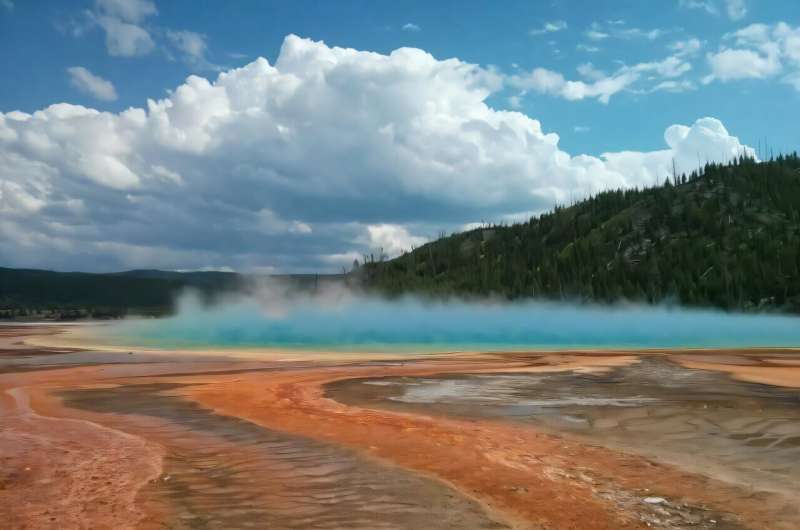Science
Machine Learning Reveals Tenfold Increase in Yellowstone Earthquakes

Researchers have discovered that machine learning can detect significantly more seismic activity in the Yellowstone caldera, uncovering approximately ten times more earthquakes than previously recorded. This finding, published on July 18, 2025, in the journal Science Advances, highlights the potential of advanced technology in enhancing our understanding of volcanic and seismic systems.
The research team, led by Bing Li from the University of Western Ontario, collaborated with colleagues from the Universidad Industrial de Santander in Colombia and the United States Geological Survey. Their comprehensive analysis of historical earthquake data spanning a 15-year period (2008 to 2022) has expanded the historical catalogue of earthquakes in Yellowstone to an unprecedented 86,276 events.
Understanding the Yellowstone Caldera
The Yellowstone caldera, located across parts of Wyoming, Idaho, and Montana, is one of the most seismically active regions in the world. A caldera forms when a volcanic eruption empties the magma chamber beneath it, causing the land above to collapse. This process differs from the formation of a volcanic crater, which involves outward explosive activity.
A crucial insight from the study is that over half of the earthquakes detected in Yellowstone are part of earthquake swarms. These swarms consist of groups of small, interconnected earthquakes occurring in a relatively small area over a short time frame. This pattern differs from aftershocks, which follow a larger main earthquake.
“While Yellowstone and other volcanoes each have unique features, the hope is that these insights can be applied elsewhere,” said Bing Li. He emphasized the importance of understanding seismic patterns to improve safety measures and guide geothermal energy development away from hazardous areas.
Advancements in Earthquake Detection
Prior to employing machine learning techniques, earthquake detection relied heavily on manual inspection by trained experts, a time-consuming and costly process. Machine learning has revolutionized this approach, enabling seismologists to analyze vast amounts of historical waveform data stored in global data centers.
“If we had to do it old school with someone manually clicking through all this data looking for earthquakes, you couldn’t do it. It’s not scalable,” noted Li. The application of machine learning allows researchers to identify more seismic events, providing a clearer picture of the seismic dynamics in the Yellowstone region.
The study also reveals that earthquake swarms beneath the Yellowstone caldera occur along relatively immature and rough fault structures, contrasting with the mature fault structures typically observed in places like southern California. By employing fractal analysis, the researchers characterized these swarms, suggesting that they arise from a combination of slowly moving underground water and sudden fluid bursts.
“To a large extent, there is no systematic understanding of how one earthquake triggers another in a swarm. We can only indirectly measure space and time between events,” Li explained. The enhanced catalogue of seismic activity allows for more robust statistical analysis, enabling researchers to identify and study new earthquake swarms that have not been previously recognized.
The findings presented in this study mark a significant advancement in the field of seismology, demonstrating the power of data-driven approaches in understanding complex geological phenomena. As researchers continue to refine their techniques, the implications for both public safety and geothermal energy exploration are substantial.
For more detailed insights, refer to the original study: Manuel Florez, Long-term dynamics of earthquake swarms in the Yellowstone caldera, Science Advances (2025), DOI: 10.1126/sciadv.adv6484.
-

 Health3 months ago
Health3 months agoNeurologist Warns Excessive Use of Supplements Can Harm Brain
-

 Health3 months ago
Health3 months agoFiona Phillips’ Husband Shares Heartfelt Update on Her Alzheimer’s Journey
-

 Science2 months ago
Science2 months agoBrian Cox Addresses Claims of Alien Probe in 3I/ATLAS Discovery
-

 Science2 months ago
Science2 months agoNASA Investigates Unusual Comet 3I/ATLAS; New Findings Emerge
-

 Science1 month ago
Science1 month agoScientists Examine 3I/ATLAS: Alien Artifact or Cosmic Oddity?
-

 Entertainment5 months ago
Entertainment5 months agoKerry Katona Discusses Future Baby Plans and Brian McFadden’s Wedding
-

 Science1 month ago
Science1 month agoNASA Investigates Speedy Object 3I/ATLAS, Sparking Speculation
-

 Entertainment4 months ago
Entertainment4 months agoEmmerdale Faces Tension as Dylan and April’s Lives Hang in the Balance
-

 World3 months ago
World3 months agoCole Palmer’s Cryptic Message to Kobbie Mainoo Following Loan Talks
-

 Science1 month ago
Science1 month agoNASA Scientists Explore Origins of 3I/ATLAS, a Fast-Moving Visitor
-

 Entertainment2 months ago
Entertainment2 months agoLewis Cope Addresses Accusations of Dance Training Advantage
-

 Entertainment3 months ago
Entertainment3 months agoMajor Cast Changes at Coronation Street: Exits and Returns in 2025









